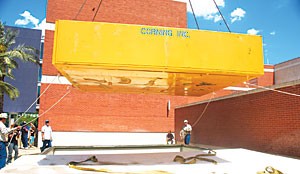A 6,700-pound mirror, which will be part of the fifth-largest telescope in the continental U.S., was unloaded at the College of Optical Sciences’ large optics shop yesterday.
The Lowell Observatory and the College of Optical Sciences have teamed up to complete the Discovery Channel Telescope’s primary mirror, which will be used in an observatory currently under construction in Happy Jack, 40 miles southeast of Flagstaff.
The telescope “”will allow astronomers to survey an area of the sky equal to 16 full moons,”” according to the Discovery Channel Telescope Web site.
A team of students working with Jim Burge, a professor in optical sciences and co-investigator on the project, will be involved in optical testing of the 14-foot diameter, 4-inch-thick mirror.
The group will design lenses that will be used with systems that independently test the mirror, such as a laser tracker and wavelength interferometer.
The UA beat out Russian-based firm LZOS for the $3 million job, said Martin Valente, director of the College of Optical Sciences.
Byron Smith, project manager and opto-mechanical engineer for the Discovery Channel Telescope, said the goal of the new observatory, which is being constructed by Lowell Observatory and Discovery Communications Inc., is to build a general-purpose research center for astronomers at Lowell.
The telescope will be used to search for near-Earth objects, extra-solar planets and exploration of the newly discovered Kuiper Belt, which is a large mass of small bodies orbiting the sun beyond the planet Neptune, according to the Lowell Web site.
“”The telescope will be called upon to do just about everything,”” Smith said.
Corning Inc., the company that cast and fused the mirror, created it out of ultra-low-expansion glass, which will begin a figuring and polishing process at the UA.
Valente said the project will provide a great opportunity to students involved.
“”I want to make it clear that we have lots of student involvement with the project,”” Valente said. “”This gives them the opportunity to really learn real-world skills on an actual product.””
Smith said the mirror shaping is highly accurate, as it will be ground down to 30 nanometers or “”30 billionths of a meter.””
If the mirror were scaled to the size of the U.S., the “”biggest bump would be an inch high,”” Smith said.
The mirror will be one of two mirrors on the telescope. While a “”wide field of view”” uses the primary mirror, a more high-resolution view will require two mirrors, Smith said.
The mirror will take two to three years to complete at the UA before it is sent to Happy Jack.









